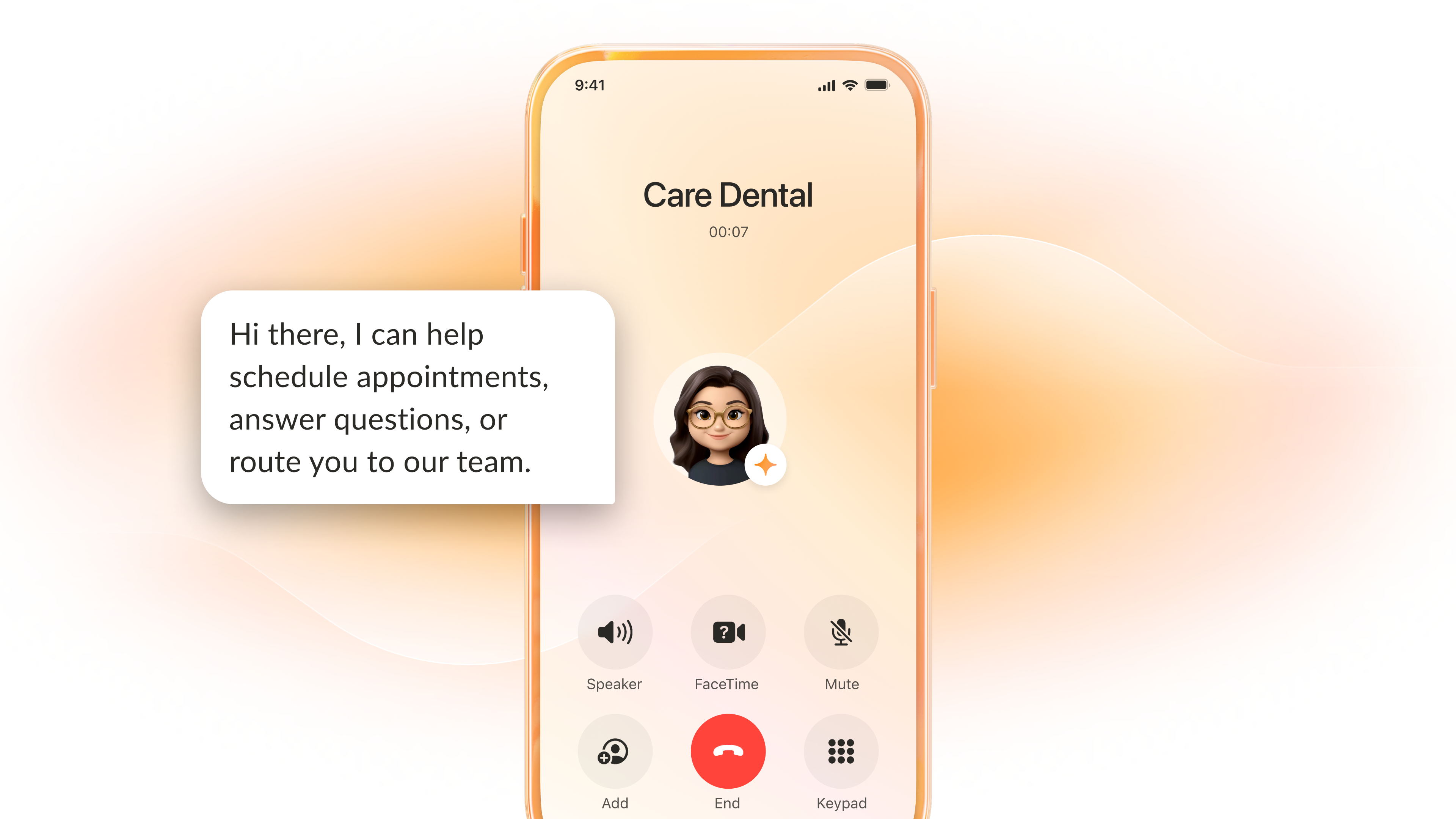RingCentral Debuts AI Receptionist, AIRRingCentral Debuts AI Receptionist, AIR
The challenge in this space is to balance the speed and convenience of virtual agents with caller antipathy toward non-human voice agents.
February 20, 2025

We are less than a month out from Enterprise Connect 2025 and I’m expecting a flurry of AI news from the show. One vendor, who got a jump on news is RingCentral, which announced a new offering that leverages generative AI to handle phone calls for those customers who prefer voice. The company says RingCentral AI Receptionist (AIR) can augment or completely replace a receptionist.
RingCentral AIR uses generative AI (GenAI) to automatically respond to questions from callers and route them to the information they seek. It’s far more streamlined than the company’s contact center intelligent virtual agents, so even small companies with tight budgets should be able to deploy it.
What AIR Offers
AI Receptionist’s capabilities at launch include:
Using generative AI informed by context from client websites and FAQs, to answer routine customer questions about a business. It can be deployed for one or multiple locations.
Smart call routing that uses natural conversation to connect callers to the right person or department.
Providing callers with SMS confirmations of important details on request.
Producing call transcripts to deliver insights about the information customers want.
Providing analytics of call volumes and trends.
RingCentral says AIR supports English today, with Spanish scheduled for the end of Q1. Also on the roadmap is AI-powered appointment scheduling.
In the press release, RingCentral wrote, “Voice remains a preferred way in which customers communicate, and AI-powered call automation—integrated directly into the phone system—will redefine how companies of all sizes connect with their customers.”
I’ll both agree and disagree with the statement. Voice is the interface we are all born with and the one that everyone can use. I do believe that voice would be the preferred medium for people if the experience was great but IVRs and other voice automation systems are poor at best forcing people to defer to messaging and other text communications. Traditional IVRs leave a lot to be desired with the best outcome often being to scream, “agent!” into the phone until one gets a live person.
Systems like Alexa and Siri tend to have high utilization rates because they work. AIR brings the ease of use of something like Alexa and marries it with an IVR enabling people to converse with it and get tasks done.
AIR answers many of the routine inquiries based on publicly available information from the customer’s website and FAQs. While this can be effective, the information provided is only as good as the data available. AIR customers can modify the information, if necessary but ensuring the data is correct is something they should focus on prior to the implementation of something like AIR.

Source: RingCentral
The Implication of Virtual Agents
In its press release, RingCentral said customers in its early access program have seen significant benefits. These range from a security company that “instantly resolved over 50% of inbound calls” to a healthcare provider that “improved patient care and experience” by “eliminating call wait times and reducing average answer times from 12 seconds to 0 seconds.”
There is no better way to show value than to highlight what actual customers are doing, and this is something that should become a best practice for all product launches. Of the two metrics, the latter is significant and shows the value of AIR and products like it. Human receptionists can only handle one call at a time where virtual agents can deal with every call in real time. In theory, once a business deploys a virtual agent, no customer should ever be put on hold again, eliminating a significant point of frustration.
The ability to handle customer calls more quickly and get people the information they seek should be a boon to businesses and consumers. However, there’s always the likelihood that some people, especially those less technically savvy, might balk at engaging with a human-like but not human virtual agent when they call their doctor, a business when they want to make a purchase or have a problem.
The challenge is to balance the speed and convenience of virtual agents who greet and direct callers with the potential creeping dread of machines eliminating human-to-human contact or the frustrations some people may feel if they can’t succinctly communicate their point to an AI solution. RingCentral and other AI-focused customer contact solution providers will have to overcome those challenges to be successful and widely accepted.
The Rise of Agentic AI – Completing Complex Tasks Without Human Intervention
Agentic AI is rapidly becoming one of those overused buzzwords. While I’ve heard multiple definitions of what success for agentic AI is, the best one was from Alexandr Wang, CEO of Scale AI where he simplified the definition by focusing on the outcome of being able to complete complex tasks without human intervention. RingCentral’s AIR adheres to this definition as some business should be able to completely replace their receptionist with it.
For RingCentral, the focus on a specific use case should help it be successful. Agentic agents are being rolled out faster that IT pros can keep up with. This makes it hard to know where to deploy them and for what use cases. By focusing on a specific job function, RingCentral can bring best practices to the table with expected results raising the likelihood of a successful deployment.
Pricing and Availability
RingCentral hasn’t provided pricing information for AI Receptionist. The company says it is available to select U.S. businesses during an initial controlled availability phase, which includes a one-month, 100-minute free trial. A larger-scale rollout is planned for the second quarter of 2025. Earlier this week I had a call with John Finch, Global VP of Product Marketing for CX and he indicated the company is looking at various options including flat rate and per call pricing.
How AI agents are priced is still one of the great unsolved mysteries in CX. We are early in the cycle and the various vendors I’ve talked to have looked at everything from outcome-based pricing to per message to flat rate.
One of the challenges for a company like RingCentral and the other CCaaS providers is that the traditional per user, per month model is easy to forecast as its highly predictable. With utilization-based pricing, seasonality becomes factor where a retailer would have higher volumes between Thanksgiving and Christmas and accounting firms will see a spike around tax time. This could have an impact on how Wall Street analysts value the company and create some additional levels of investor risk.
For RingCentral, the starting point of a flat rate for 100 minutes seems to be reasonable and something the company can build on or tweak as necessary.
Final Thoughts
One of the questions I get asked is will business embrace virtual agents to replace receptionists. To get a better understanding of the demand, I talked with Chris Frey, VP Solutions Architects at Converged Technology Professionals, one of RingCentral’s partners. He was optimistic about AIR’s prospects in the market because of the changing dynamics of work.
“Organizations are increasingly resistant to backfilling operator roles as employees leave due to attrition. With hybrid and remote work reducing the need for in-person greeters, the operator role often falls to a committee—one that doesn’t want to answer phones. Traditional automated attendants lack the sophistication to handle basic inquiries or navigate large employee directories for call transfers. In contrast, AI bots can manage complex queries, making them a compelling alternative,” Frey said. “Customers want AI Receptionists that can cross-reference multiple, dynamic data sources to route calls accurately. This is essential as employee directories and responsibilities shift by the hour. [But,] skepticism remains. To gain adoption, providers must deliver seamless, well-executed demos that showcase real-world effectiveness.”
I’m expecting to see a flurry of AI agents announced over the course of 2025. For buyers, there is no easy button to evaluate the various offerings. My advice is to find a vendor you want to work with and trial the product and see how it works in that specific environment. Does it work with the languages you need? Does it understand industry specific vernacular, how easy is it to set up and change? We are too early in the cycle for standardized features, so every vendor will likely yield slightly different results.
AIR is a good announcement for RingCentral, a company looking to establish itself as a mainstream CX provider – but this should be thought of as the starting point. As Frey pointed out, the opportunity is wide open but RingCentral will need to continue to demonstrate AIR’s value through customer use cases. More to come, I’m sure.
About the Author
You May Also Like





